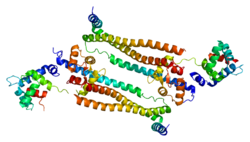Proteolytic modification
In apoptotic cardiomyocytes, cTnT was cleaved by caspase 3 to generate a 25-kDa N-terminal truncated fragment. [36] This destructive fragmentation removes a part of the middle region tropomyosin binding site 1, [22] leading to attenuation of the myofilament force production by decreasing the myosin ATPase activity. [36]
In cardiac muscle under stress conditions, cardiac TnT is cleaved by calpain I, restrictively removing the entire N-terminal variable region. [37] [38] This proteolytic modification of cTnT occurs in cardiac muscle in acute ischemia-reperfusion or pressure overload. [39]
The restrictively N-terminal truncated cTnT remains functional in the myofilaments and leads to reduced contractile velocity of the ventricular muscle, which extends the rapid ejection phase and results in an increase in stroke volume, especially under increased afterload. [39] In vitro studies showed that N-terminal truncated cTnT preserved the overall cardiac myofilament calcium sensitivity and cooperativity, but altered TnT's binding affinities for tropomyosin, TnI and TnC proteins, [40] [41] and lead to slightly decreased maximum myosin ATPase activity and myofilament force production, which forms the basis of the selective decrease in contractile velocity of ventricular muscle to increase stroke volume without significant increase in energy expenditure. [39]
With the relatively short half-life of cTnT in cardiomyocytes (3–4 days), [42] the N-terminal truncated cTnT would be replaced by newly synthesized intact cTnT in several days. Therefore, this mechanism provides a reversible posttranslational regulation to modulate cardiac function in adaptation to stress conditions.
Phosphorylation sites in cTnT in comparison with ssTnT and fsTnT| Phosphorylation site | Kinase | Function | Reference |
|---|
| cTnT | ssTnT | fsTnT |
|---|
| Ser2 | c | c | PKC | Unknown | [43] [44] [45] |
| Thr197 | n | N | PKC | No functional effect | [31] [46] |
| Ser201 | n | n | PKC | No functional effect | [31] [46] |
| Thr204 | n | n | PKC | Reduce Myosin ATPase activity, myofilament force production and Ca2+ sensitivity | [46] [47] [48] |
| Thr204 | n | n | CaMK II | Unknown | [49] |
| Thr204 | n | n | ASK I | Reduce cardiomyocyte contractility | [34] |
| Thr206 | | | PKC | Reduce Ca2+ sensitivity, actomyosin ATPase activity and tension development | [31] |
| Ser208 | n | n | PKC | Reduce Myosin ATPase activity, alter myofilament Ca2+ sensitivity | [46] [48] [50] |
| Ser208 | n | n | ASK I | Reduce cardiomyocyte contractility | [34] |
| Thr213 | c | c | PKC | Reduce Myosin ATPase activity, myofilament force production and Ca2+ sensitivity | [51] |
| Thr213 | c | c | Raf-1 | Unknown | [52] |
| Ser285 | n | c | PKC | Reduce Myosin ATPase activity, myofilament force production and Ca2+ sensitivity | [50] |
| Ser285 | n | c | ROCK-II | Reduce myofilament force development, Myosin ATPase activity and Ca2+ sensitivity | [35] |
| Thr294 | n | n | PKC | Reduce Myosin ATPase activity, myofilament force production and Ca2+ sensitivity | [46] [47] [48] [50] |
| Thr294 | n | n | ROCK-II | Reduce myofilament force development, myosin ATPase activity and Ca2+ sensitivity | [35] |
The residues in cardiac TnT with phosphorylation regulations are summarized. The residue numbers for phosphorylatable serine and threonine are that in human cardiac TnT with the first methionine included. The phosphorylation of cardiac TnT at these residues is compared with the counterparts in fast TnT and slow TnT. C, conserved; N, non-conserved. Kinases responsible for each phosphorylation, functional effects, and references are also listed.










